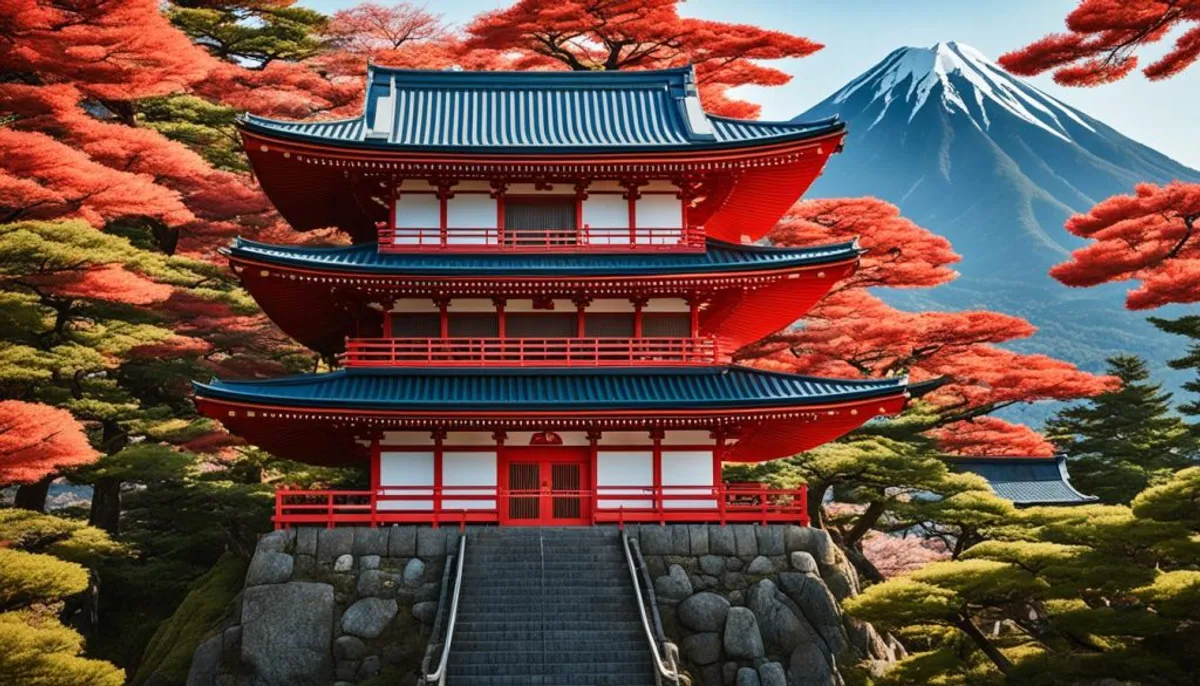The Japanese administrative system has unique territorial divisions that make it fascinating. At the center, we have the prefectures. They are vital for local government and regional administrations in Japan. Understanding the role of the prefectures helps to better see the political organization of Japan and its administrative hierarchy.
There are 47 prefectures in Japan, each belonging to one of four types. We distinguish the metropolitan prefecture (to), the island prefecture (dō), urban governments (fu), and rural departments (ken). This prefectural structure is essential for Japanese public institutions.
Main points to remember
- The prefectures are the largest administrative subdivision in Japan, created in 1871.
- They are divided into four types (to, dō, fu, ken) with geographical and historical specificities.
- The prefectures play a central role in the territorial organization and administrative system of the country.
- Each prefecture has its own local government, between the national and municipal levels.
- The prefectural division replaced the old feudal provinces during the Meiji era.
Introduction
There are 47 prefectures in Japan. They were created in 1871 as part of the Meiji era reform. Each represents an administrative district.
Definition of a prefecture in Japan
Each prefecture has its own responsibilities. They help decentralize public services across the Japanese territory. Thus, they form a link between the national government and local cities.
Importance of prefectures in Japanese territorial organization
The prefectures are essential in the daily life of the Japanese. They manage services such as education and health. They also participate in regional economic development.
What is a prefecture in Japan?
A Japanese prefecture is a large administrative area in Japan. There are 47 prefectures, each with its own government. They help manage local, economic, and social affairs, notably through initial training for prefects.
The prefectures vary in size and type. There are metropolises like Tokyo and rural areas. This shows the diversity of the country and its government.
| Type of prefecture | Number | Characteristics |
|---|---|---|
| Metropolitan prefecture (to) | 1 | Corresponds to the former urban prefecture of Tokyo, which became the "Tokyo Metropolis" in 1943. |
| Island prefecture (dō) | 1 | The prefecture of Hokkaidō is the only fully island prefecture, subdivided into sub-prefectures. |
| Urban governments (fu) | 2 | The prefectures of Osaka and Kyoto have a special status as "urban governments," inherited from the Edo period. |
| Rural departments (ken) | 43 | Although labeled "rural," most are now heavily urbanized. |
These 47 prefectures together form Japan as we know it. They play an essential role in regional life.
The four types of prefectures
The 47 Japanese prefectures are grouped into four different types. These categories reflect the history and geographical particularities of each region.
Metropolitan prefecture (to)
The metropolitan prefecture (都, to) is unique. It was first the urban prefecture of Tokyo (fu), created in 1868. In 1943, it became a "Metropolis" (東京都, Tōkyō-to).
Island prefecture (dō)
Hokkaidō is the only prefecture that is an island. As an island prefecture (道, dō), it is divided into sub-prefectures. It was integrated into the Japanese administration during the Meiji era. Previously, this region was known as the "island of Ezo."
Urban governments (fu)
Osaka (大阪府, Osaka-fu) and Kyoto (京都府, Kyōto-fu) are "urban governments" (府, fu). They originated from the "Domains directly managed by the magistrates of the bakufu" during the Edo period. These administrative structures date back to the feudal era.
Rural departments (ken)
Japan has 43 "rural departments" (県, ken). These departments are part of the most populated regions. Even though they are called "rural," they are very urbanized today.
Subdivisions of prefectures
To manage their territory, Japanese prefectures create sub-prefectures (支庁, shichō). This is particularly evident in Hokkaidō and the islands adjacent to Tokyo.
Sub-prefectures
These subdivisions, including the districts of Yopougon, help to better organize the territory. They improve the coordination of services for local citizens.
Districts
Next, rural areas are divided into districts or "counties." This serves for postal addresses and organization, but it has no administrative effect.
Geographical groupings
Some prefectures group cities according to natural or cultural areas. Even though these groupings have no official recognition, they help to manage certain local affairs together.
History of the creation of prefectures
The prefectural system began in 1871, during the Meiji era, with a specific goal. This government wanted to change the old feudal regions.
Meiji era reform in 1871
The old regions were not clearly abolished, but the division into prefectures replaced them. This practically changed the boundaries of the territories.
Hokkaidō Prefecture
Previously, Hokkaidō was called the island of Ezo. It is the only prefecture in Japan that is an island. In the Meiji era, it joined the Japanese administration.
Only island prefecture in Japan
Hokkaidō began under a Development Commission. From 1871 to 1886, it was divided into three parts. Then, it became a single prefecture. It retains the name Hokkaidō with the suffix "dō."
Creation and historical evolution
It covers 83,456.64 km² and had 5,231,685 people in November 2020. This makes it sparsely populated, with 62.69 inhabitants per km². Its capital is Sapporo.
| Key indicators | Values |
|---|---|
| Area | 83,456.64 km² |
| Population (November 2020) | 5,231,685 inhabitants |
| Population density | 62.69 inhabitants/km² |
| Percentage of water | 6.4% |
| Number of sub-prefectures | 14 |
| Number of rural districts | 68 |
| Number of municipalities | 180 |
| Capital | Sapporo |
Hokkaidō supports the economy of Japan, particularly agriculture and agribusiness. In 2021, it produced over 66% of the national wheat, 78% of potatoes, and 43% of soybeans.
Kyoto and Osaka Prefectures
The prefectures of Kyoto and Osaka are different from others. They are called "urban governments" (fu). This name comes from the "Domains directly managed by the magistrates of the bakufu" during the Edo period.
Status of "urban governments"
During the Edo period, there were nine "Directly Managed Domains." When Japan created the prefectural system in 1871, Kyoto and Osaka were already very strong. That is why they retained their name of fu. Being an "urban government" is a special title that these prefectures hold. It separates them from more rural areas in the country.
Historical origins
Following the Edo period, Kyoto and Osaka began as "Directly Managed Domains." These places had their own way of managing things. Even after the 1871 reform, they remained strong "urban governments" (fu). This is an important part of their history.

Administrative role of prefectures
The prefectures are key in the organization of Japan. They work with local cities and manage regional public services.
Relations with municipalities
They have strong ties with urbanized areas. These relationships help to better distribute services across the entire Japanese territory, especially in the context of sub-prefecture management.
Public services and institutions
The prefectures each help manage important sectors. This includes but is not limited to education, health, and transportation.
Prefecture and geographical division
Japan has about 20,000 islands and islets. Each is linked to a prefecture. This facilitates administration and their service. Even when distant, these islands remain united with Japan through its prefectures.
Islands attached to prefectures
The Japanese islands can be very far from the mainland. Yet, they still depend on a prefecture. The latter manages them and connects them to the country, thus unifying the Japanese territory.
Natural regions and traditional countries
The Japanese prefectures sometimes group municipalities by natural regions or traditions. Even informal, these groupings help to understand the cultural variety of the country, including foreign cuisine restaurants. They enrich our view of local communities.
Japanese public institutions
The prefectures are very important in the Japanese administrative organization. They are positioned between the central government and the cities. These institutions help manage political affairs and public services locally.
Administrative hierarchy
Each prefecture has its own local government. It includes an elected governor and an assembly. Together, they govern the affairs of the region, in cooperation with the cities.
Prefectural administrative system
Japan uses a decentralization system. This spreads power and public services throughout the territory. Thus, the prefectures can better implement national decisions adapted to their region.

Examples of notable prefectures
Tokyo, capital prefecture
The Tokyo prefecture was called the "Tokyo Metropolis." It is a unique metropolitan prefecture. It has over 14 million inhabitants and a high population density.
It houses the main centers of Japan. These places include the seat of government and parliaments.
Kumamoto and its volcanic history
Kumamoto is located on the island of Kyūshū. This region is famous for its volcano, Mount Aso, one of the largest in the world. Volcanic activity has shaped the landscape and influenced the culture of the prefecture.
Territorial divisions in Japan
Japan has 47 prefectures, each with its own geographical identity. These prefectures have been the basic administrative unit of the country since 1871. They were created after the abolition of the old feudal provinces.
Prefectures and political organization
In each prefecture, there is a local government led by an elected governor. This government works with a prefectural assembly to make important decisions. The prefectures help distribute government tasks and public services throughout the country.
Historical evolution of the division
Even though the old provinces still exist in one way or another, they have been replaced by the prefectures. This change was made to establish a more modern system. Today, this organization helps to better structure the country.
FAQ
What is a prefecture in Japan?
In Japan, a prefecture is a large administrative area. There are 47 prefectures, each with a specific role. They help organize the country, and each administrative organization plays a key role in this structure.
What is the definition of a prefecture in Japan?
Since 1871, Japan has been divided into 47 administrative areas called prefectures. This division took place during the Meiji era reform.
What is the role of prefectures in Japanese territorial organization?
The prefectures help decentralize power in Japan. They play a crucial role between the national government and local communities.
They also help provide public services to everyone effectively.
What are the four types of prefectures in Japan?
In Japan, there are four types of prefectures. This includes the metropolitan prefecture, the island prefecture, urban governments, and rural departments.
What is a sub-prefecture?
Prefectures can divide their territory into sub-prefectures. This helps to better manage regions. This practice is particularly common in Hokkaidō and the islands around Tokyo.
When was the current system of prefectures established?
The prefectural system as we know it was born in 1871. The Meiji era established it to replace old divisions.
What distinguishes Hokkaidō Prefecture?
Hokkaidō is unique in Japan; it is an island prefecture. Before the Meiji era, it was known as the island of Ezo.
What is the special status of the prefectures of Kyoto and Osaka?
Kyoto and Osaka have a special status. They are called "urban governments" and trace their origin back to the Edo period.
What are the administrative roles of the prefectures?
The prefectures work closely with cities and villages. They handle services such as education, health, and transportation in a decentralized manner.
How are the islands of the Japanese archipelago attached?
Each island of the Japanese archipelago is managed by a prefecture. Even when distant, they depend on the prefecture for services and administration.
What is the role of prefectures in the Japanese administrative hierarchy?
The prefectures are important in Japan, positioned between the central government and local administrations. Each has its governor and assembly to lead it.
What are the most notable prefectures?
Tokyo is a very special prefecture, with a major role and national institutions. Kumamoto, in Kyūshū, is known for its volcanoes, particularly Mount Aso.
RelatedRelated articles



